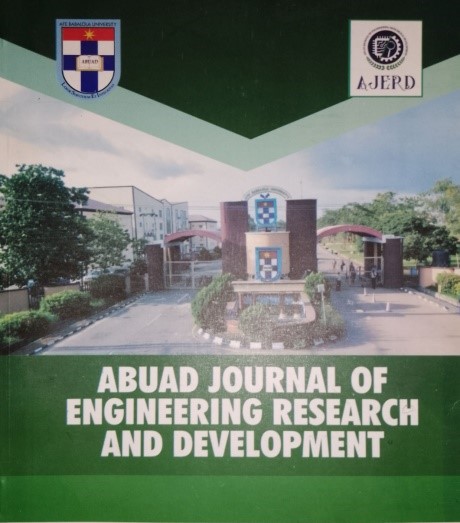Comparative Study on the Variability Margin of Concrete Strength between Weight and Volume Batching Methods
Main Article Content
Abstract
Variability of strength in concrete has significant effect on the structural integrity, safety and performance of every concrete structure. It is a valid concern which defies any mix design method, but depends changes in material, production process and environmental condition. The aim of this study is to determine the effect of the batching method on the margin of variability of concrete strength. Methods of batching by weight and volume were considered for three popular nominal mix proportions including 1:2:4, 1:1.5:3 and 1:1:2. The standard deviation of the 28th day compressive strength was determined and analysed for quantitative and qualitative assessment of concrete quality. The result indicates that lower water/cement ratio recorded higher compressive strength for the same mix proportions under both weight and volume batched method. The three mixes of ratios 1:2:4, 1:1.5:3 and 1:1:2 that were weight batched outperform the volume batch of the same mix ratios in compressive strength by 33.8%, 14.5% and 24.9% respectively. It was concluded that volume batched mixes may only be considered for on – site concrete construction when water/cement ratio can be strictly controlled or stiff mixes are applicable as well as characteristic strength of concrete is below 25N/mm2. Where these conditions cannot be met, batching by weight with controlled water/cement ratio should be considered for on – site concrete construction. This study recommended the development of mix design template suitable for volume batched mixes considering several factors promoting variability in concrete strength, through the collective efforts of researchers, site engineers and regulatory bodies.
Downloads
Article Details

This work is licensed under a Creative Commons Attribution-NonCommercial-ShareAlike 4.0 International License.
References
Zhang, X., Akber, M.Z., & Zheng, W. (2022). Predicting the Slump of Industrially Produced Concrete Using Machine Learning: A Multiclass Classification Approach. Journal of Building Engineering 58, 104997 https://doi.org/10.1016/j.jobe.2022.104997
Sowmya, N., Sanjay, B., Preetham, C., Madhu, M., & Niharika, G. (2024). Experimental Investigation on Binary and Ternary Blended Concrete. Material Science and Technology. 23(05), 566 – 576. http://materialsciencetech.com/mst
Hattani, F., Menu, B., Allaoui, D., Mouflih, M., Zanzoun, H., Hannache, H. & Manoun, B. (2024). Evaluating the Impact of Material Selections, Mixing Techniques, and On-Site Practices on Performance of Concrete Mixtures. Civil Engineering Journal, 10(2), 571 – 598, http://dx.doi.org/10.28991/CEJ-2024-010-02-016
Abosede, A. O., Opawole, A., Olubola, B., Ojo, G. K. & Kajimo – Shakantu, K. (2019). Performance Analysis of Small and Medium – Sized Construction Firms in Oyo State, Nigeria. Acta Structilia, 26(1), 66 – 96.
Aniekwu, A. (1995) The Business Environment of the Construction Industry in Nigeria. Construction Management and Economics, 13(6), 445 – 455. https://doi.org/10.1080/01446199500000052
Shakantu, W.M., Kajimo-Shakantu, K., Saidi, F. & Mainga, W. (2006). Bridging the Informal, Formal and Indigenous Construction Knowledge System to Resolve the Construction Skills Shortage. Paper delivered at the 4th Postgraduate Conference of the CIDB on Construction Industry Development, 8-10 October, Stellenbosch, South Africa.
Marsh, B. K. (1997) Design of Normal Concrete Mixes, 2nd Edition, Construction Research Communications Ltd. Rosebery Avenue London. dosen.upi-yai.ac.id 201_20241109133314_DOESTANDART
Khan, M.I. & Abbas, Y.M. (2023). Intelligent Data-Driven Compressive Strength Prediction and Optimization of Reactive Powder Concrete Using Multiple Ensemble-based Machine Learning Approach. Construction and Building Material, 404, 133148 https://doi.org/ 10.1016/j.conbuildmat.2023.133148.
Han, S.H., Khayat, K.H., Park, S. & Yoon, J. (2024). Machine Learning-based Approach for Optimizing Mixture Proportion of Recycled Plastic Aggregate Concrete Considering Compressive Strength, Dry Density, and Production Cost. Journal of Building Engineering 83, 108393 https://doi.org/10.1016/j.jobe.2023.108393
Tao, J., He, J., Xiong B., & Song, Y. (2024) Description of the Spatial Variability of Concrete via Composite Random Field and Failure Analysis of Chimney. Probabilistic Engineering Mechanics, 77
Tutu, K. A., Odei, D. A., Baniba, P., & Owusu, M. (2022). Concrete Quality Issues in Multistory Building Construction in Ghana: Cases Studies Kumasi Metropolis. Construction Materials, 17:e01425. https://doi.org/10.1016/j.cscm.2022.e01425.
ACI (2011). ACI Committee 214: Guide to Evaluation of Strength Test Results of Concrete (ACI 214R-11). American Concrete Institute, Farmington Hills, USA
Boukendakji, M. (2017) Strength Quality Control for Ready Mixed Concrete. International Journal of Advanced and Applied Sciences, 4(10), 139 – 143. https://doi.org/10.21833/ijaas.2017.010.019.
Leykin, A. P., Belentsov, Y. A. & Kazanskaya, L. F. (2023). Implications of the Compressive Strength Control Accuracy on the Probability of Accepting Defective Concrete Elements. E3S Web of Conferences 460, 10048. https://doi.org/10.1051/ e3sconf/202346010048
BS EN 12350 – 2 (2019). Testing Fresh Concrete. Slump Test British Standard Institution. London
BS EN 12390 – 3 (2019). Testing Hardened Concrete. Compressive strength of test specimens. British Standard Institution. London




